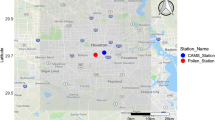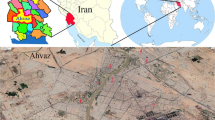Abstract
Millions of people have an allergic reaction to pollen. The impact of pollen allergies is on the rise due to increased pollen levels caused by global warming and the spread of highly invasive weeds. The production, release, and dispersal of pollen depend on the ambient weather conditions. The temperature, rainfall, humidity, cloud cover, and wind are known to affect the amount of pollen in the atmosphere. In the past, various regression techniques have been applied to estimate and forecast the daily pollen concentration in the atmosphere based on the weather conditions. In this research, machine learning methods were applied to the Next Generation Weather Radar (NEXRAD) data to estimate the daily Ambrosia pollen over a 300 km × 300 km region centered on a NEXRAD weather radar. The Neural Network and Random Forest machine learning methods have been employed to develop separate models to estimate Ambrosia pollen over the region. A feasible way of estimating the daily pollen concentration using only the NEXRAD radar data and machine learning methods would lay the foundation to forecast daily pollen at a fine spatial resolution nationally.







Similar content being viewed by others
References
Arizmendi, C., Sanchez, J., Ramos, N., Ramos, G. (1993). Time series predictions with neural nets: application to airborne pollen forecasting. International Journal of Biometeorology, 37(3), 139–144.
Biau, G., Devroye, L., Lugosi, G. (2008). Consistency of random forests and other averaging classifiers. Journal of Machine Learning Research, 9, 2015–2033.
Breiman, L. (2001). Random forests. Machine Learning, 45(1), 5–32.
Csépe, Z., Makra, L., Voukantsis, D., Matyasovszky, I., Tusnády, G., Karatzas, K., Thibaudon, M. (2014). Predicting daily ragweed pollen concentrations using Computational Intelligence techniques over two heavily polluted areas in Europe. Science of the Total Environment, 476, 542–552.
D’Amato, G., & Spieksma, F.T.M. (1991). Allergenic pollen in Europe. Grana, 30(1), 67–70.
D’Amato, G., Liccardi, G., Frenguelli, G. (2007). Thunderstorm-asthma and pollen allergy. Allergy, 62(1), 11–16.
D’Amato, G., Rottem, M., Dahl, R., Blaiss, M.S., Ridolo, E., Cecchi, L., Rosario, N., Motala, C., Ansotegui, I., Annesi-Maesano, I. (2011). Climate change, migration, and allergic respiratory diseases: an update for the allergist. World Allergy Organization Journal, 4(7), 121.
Hagan, M.T., & Menhaj, M.B. (1994). Training feedforward networks with the Marquardt algorithm. IEEE transactions on Neural Networks, 5(6), 989–993.
Haykin, S. (1994). Neural networks: a comprehensive foundation. New York: Macmillan College Publishing Company.
Haykin, S.S., & et al. (2001). Kalman filtering and neural networks. Wiley Online Library.
Haykin, S. (2009). Neural networks and learning machines (Vol. 3). Upper Saddle River: Pearson.
Howard, L.E., & Levetin, E. (2014). Ambrosia pollen in Tulsa, Oklahoma: aerobiology, trends, and forecasting model development. Annals of Allergy, Asthma & Immunology, 113(6), 641–646.
Kasprzyk, I. (2008). Non-native Ambrosia pollen in the atmosphere of Rzeszów (se Poland); evaluation of the effect of weather conditions on daily concentrations and starting dates of the pollen season. International Journal of Biometeorology, 52(5), 341–351.
Kinney, P.L. (2008). Climate change, air quality, and human health. American Journal of Preventive Medicine, 35(5), 459–467.
Kohavi, R. (1995). A study of cross-validation and bootstrap for accuracy estimation and model selection. In Proceedings of the Fourteenth International Joint Conference on Artificial Intelligence (pp. 1137–1143). San Francisco: Morgan Kaufmann.
Laaidi, M., Laaidi, K., Besancenot, J.-P., Thibaudon, M. (2003). Ragweed in France: an invasive plant and its allergenic pollen. Annals of Allergy, Asthma & Immunology, 91(2), 195–201.
Lake, I.R., Jones, N.R., Agnew, M., Goodess, C.M., Giorgi, F., Hamaoui-Laguel, L., Semenov, M.A., Solomon, F., Storkey, J., Vautard, R., et al. (2016). Climate change and future pollen allergy in Europe. Environmental Health Perspectives. 125(3):385–391.
Lary, D.J. (2010). Artificial intelligence in geoscience and remote sensing. INTECH Open Access Publisher.
Lary, D.J., Zewdie, G.K., Liu, X., Wu, D., Levetin, E., Allee, R.J., Malakar, N., Walker, A., Mussa, H., Mannino, A. (2018). Machine learning applications for earth observation. Earth Observation Open Science and Innovation, 165.
Liaw, A., & Wiener, M. (2002). Classification and regression by randomForest. R News, 2(3), 18–22.
Liu, X., Wu, D., Zewdie, G. K., Wijerante, L., Timms, C.I., Riley, A., Levetin, E., Lary, D.J. (2017). Using machine learning to estimate atmospheric ambrosia pollen concentrations in Tulsa, OK. Environmental Health Insights, 11, 1–10.
Molina, R.T., Palacios, I.S., RodrÍguez, A.F.M., Muñoz, J.T., Corchero, A. M. (2001). Environmental factors affecting airborne pollen concentration in anemophilous species of plantago. Annals of Botany, 87(1), 1–8.
Nowosad, J. (2016). Spatiotemporal models for predicting high pollen concentration level of Corylus, Alnus, and Betula. International Journal of Biometeorology, 60(6):843–855.
Rodríguez-Rajo, F., Astray, G., Ferreiro-Lage, J., Aira, M., Jato-Rodriguez, M., Mejuto, J.C. (2010). Evaluation of atmospheric Poaceae pollen concentration using a neural network applied to a coastal Atlantic climate region. Neural Networks, 23(3), 419–425.
Sánchez-Mesa, J., Galán, C., Martínez-Heras, J., Hervás-Martínez, C. (2002). The use of a neural network to forecast daily grass pollen concentration in a Mediterranean region: the southern part of the Iberian Peninsula. Clinical & Experimental Allergy, 32(11), 1606–1612.
Stark, P.C., Ryan, L.M., McDonald, J.L., Burge, H.A. (1997). Using meteorologic data to predict daily ragweed pollen levels. Aerobiologia, 13(3), 177–184.
Verikas, A., Gelzinis, A., Bacauskiene, M. (2011). Mining data with random forests: a survey and results of new tests. Pattern Recognition, 44(2), 330–349.
Voukantsis, D., Niska, H., Karatzas, K., Riga, M., Damialis, A., Vokou, D. (2010). Forecasting daily pollen concentrations using data-driven modeling methods in Thessaloniki, Greece. Atmospheric Environment, 44(39), 5101– 5111.
Wayne, P., Foster, S., Connolly, J., Bazzaz, F., Epstein, P. (2002). Production of allergenic pollen by ragweed (Ambrosia artemisiifolia L.) is increased in CO2-enriched atmospheres. Annals of Allergy, Asthma & Immunology, 88(3), 279–282.
Zewdie, G.K., Liu, X., Wu, D., Lary, D.J. (in press 2019). Applying machine learning to forecast daily ambrosia pollen using environmental and NEXRAD radar parameters. Environmental Monitoring and Assessment, 191.
Zhao, F., Elkelish, A., Durner, J., Lindermayr, C., Winkler, J.B., Ruëff, F., Behrendt, H., Traidl-Hoffmann, C., Holzinger, A., Kofler, W., et al. (2016). Common ragweed (Ambrosia artemisiifolia L.): allergenicity and molecular characterization of pollen after plant exposure to elevated NO2. Plant, Cell & Environment, 39(1), 147–164.
Author information
Authors and Affiliations
Corresponding author
Additional information
Publisher’s note
Springer Nature remains neutral with regard to jurisdictional claims in published maps and institutional affiliations.
Rights and permissions
About this article
Cite this article
Zewdie, G.K., Lary, D.J., Liu, X. et al. Estimating the daily pollen concentration in the atmosphere using machine learning and NEXRAD weather radar data. Environ Monit Assess 191, 418 (2019). https://doi.org/10.1007/s10661-019-7542-9
Received:
Accepted:
Published:
DOI: https://doi.org/10.1007/s10661-019-7542-9




